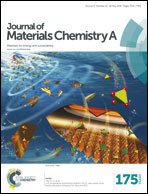Active sites-enriched hierarchical MoS2 nanotubes: highly active and stable architecture for boosting hydrogen evolution and lithium storage†
Abstract
The design of nanostructures with sufficient active sites is considerably challenging but highly desirable for energy applications. Herein, highly active tubular MoS2 structures on flexible three-dimensional graphene foam are firstly produced by a bottom-up approach using Ni3S2 nanowires as the precursor and self-sacrificial template. The hierarchical tubular structures with high surface curvature expose a large fraction of edge sites and defects, which, along with high surface area, lead to excellent activity for electrocatalytic hydrogen evolution. Remarkably, the integrated hydrogen-evolving electrode operating in acidic electrolytes exhibits high stability and excellent electrocatalytic activity with a low onset overpotential of 77 mV, Tafel slope of 52 mV per decade and large exchange current density of 6.4 × 10−2 mA cm−2. When evaluated as an anode material for LIBs, these hierarchical MoS2 nanotubes manifest high specific capacity and excellent rate capability as well as extremely long-term cycle stability. This work elucidates how structure design of nanomaterials can significantly impact the surface structure at the atomic scale, enabling new opportunities for enhancing structure properties and other important technological applications.


 Please wait while we load your content...
Please wait while we load your content...